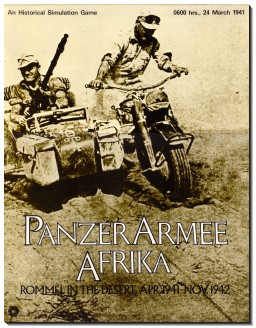
PanzerArmee Afrika, subtitled "Rommel in the Desert, April 1941 - November 1942", is a board wargame published by Simulations Publications, Inc. (SPI) in 1973 that simulates the World War II North African Campaign that pitted the Axis forces commanded by Erwin Rommel against Allied forces. The game was revised and republished in 1984 by Avalon Hill.
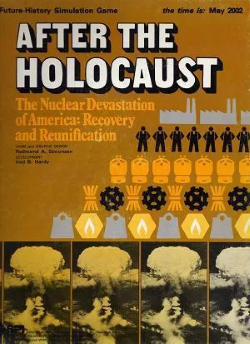
After the Holocaust, subtitled "The Nuclear Devastation of America: Recovery and Reunification", is a near-future board wargame published by Simulations Publications, Inc. (SPI) in 1976 that simulates the economic recovery of the United States following a nuclear war. The game was the third and last in SPI's "Power Politics" series.
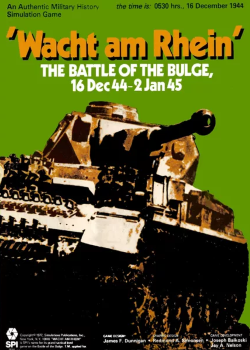
Wacht am Rhein is a grand tactical monster board wargame published by Simulations Publications, Inc. (SPI) in 1977 that simulates Germany's Battle of the Bulge offensive in late 1944 during World War II.

Blitzkrieg Module System is a series of expansion modules published by Simulations Publications Inc. (SPI) in 1969 that are designed to be used with the Avalon Hill board wargame Blitzkrieg.
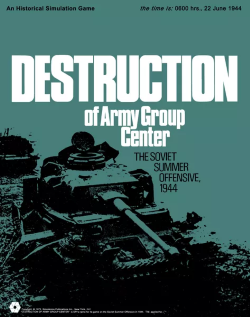
Destruction of Army Group Center, subtitled "The Soviet Summer Offensive, 1944" and often shortened to DAGC, is a board wargame published by Simulations Publications Inc. (SPI) in 1973 that simulates Operation Bagration, the June 1944 Soviet offensive during World War II that shattered the German line and marked the start of Germany's long retreat back to Berlin and the end of the war.

Foxbat & Phantom, subtitled "Tactical Aerial Combat in the 1970's", is a board wargame published by Simulations Publications Inc. (SPI) in 1973 that simulates aerial dogfights using jet aircraft technology from the early 1970s.

The Game of France, 1940: German Blitzkrieg in the West, originally titled "The Battle for France, 1940", is a board wargame originally published by Simulations Publications Inc. (SPI) in 1971 that was subsequently re-issued by Avalon Hill in 1972. Both editions simulate the World War II Battle of France in 1940, when the German blitzkrieg offensive overwhelmed French and British defenses in northern France.

MechWar '77, subtitled "Tactical Armored Combat in the 1970s", is a board wargame published by Simulations Publications Inc. (SPI) in 1975 that simulates hypothetical tank combat in the mid-1970s between various adversaries, using the same rules system as the previously published Panzer '44.

Minuteman: The Second American Revolution is a board wargame published by Simulations Publications Inc. (SPI) in 1976 that hypothesizes a modern-day revolution in United States as the result of widespread unrest.
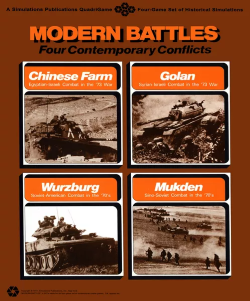
Modern Battles: Four Contemporary Conflicts is a collection of four board wargames published by Simulations Publications Inc. (SPI) in 1975 that simulates four modern-day battles set in the early 1970s.

The Moscow Campaign, subtitled "Strike and Counterstrike Russia", is a board wargame published by Simulations Publications Inc. (SPI) in 1972 that simulates combat near Moscow during World War II.

Tannenberg is a board wargame published by Simulations Publications Inc. (SPI) in 1969 that simulates the Battle of Tannenberg on World War I's Eastern Front. The game was created by game designer Jim Dunnigan as a companion piece for Avalon Hill's Western Front wargame 1914, also designed by Dunnigan. Although Tannenberg could be played as a standalone game, rules were included to combine it and 1914 into a two-front wargame. Nine years later, Tannenberg was completely revised and republished as a free pull-out game in SPI's house magazine Strategy & Tactics to promote SPI's upcoming release of The Great War in the East. The second edition was also sold as a standalone game.

A Mighty Fortress, subtitled "Reformation and Counter-Reformation, 1532-1555", is a board wargame published by Simulations Publications Inc. (SPI) in 1977 that simulates the political and religious wars of the Reformation and Counter-Reformation that enveloped Europe in the 16th century. The title is taken from a famous hymn by Martin Luther.

Breakout & Pursuit: The Battle for France, 1944 is a board wargame published by Simulations Publications Inc. (SPI) in 1972 that simulates the breakout of Allied forces from Normandy during World War II, and their subsequent pursuit of retreating German forces.
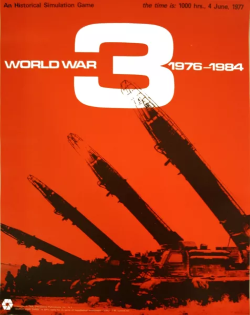
World War 3: 1976–1984 is a Cold War-era board wargame published by Simulations Publications Inc. (SPI) in 1975 that simulates a hypothetical non-nuclear war for control of the world set in the 1970s. The game sold very well, and was one of SPI's top-selling games for almost a year.

Revolt in the East, subtitled "Warsaw Pact Rebellion in the 1970's", is a Cold War-themed board wargame published by Simulations Publications Inc. (SPI) in 1976 that simulates a hypothetical rebellion of Warsaw Pact states against the Soviet Union, with possible intervention by NATO forces.

Strike Force One, subtitled "The Cold War Heats Up — 1975", is a board wargame published by Simulations Publications Inc. (SPI) during the Cold War in 1975 that simulates a hypothetical clash in West Germany between Soviet Union invaders, and American defenders. The short and simple game was designed as an introduction to the hobby of wargaming, and was given away as a free promotional item.

Wolfpack, subtitled "Submarine Warfare in the North Atlantic, 1942–44", is a solitaire board wargame published by Simulations Publications Inc. (SPI) in 1974 that simulates a four-month period during the Battle of the Atlantic.

Russian Civil War 1918–1922 is a board wargame published by Simulations Publications Inc. (SPI) in 1976 that simulates the Russian Civil War. It sold well and remained a popular and sought after game for many years after its publication.

The Ardennes Offensive , subtitled "The Battle of the Bulge, December 1944", is a board wargame published by Simulations Publications, Inc. ( in 1973 that simulates the Battle of the Bulge during World War II.




















